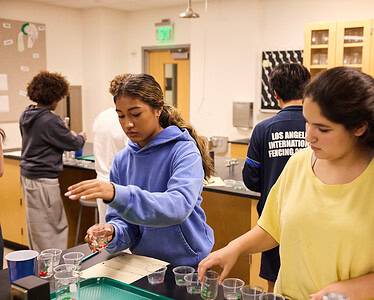By Charlie ’23
For anyone interested in taking computer programming classes, Harvard-Westlake has a plethora of opportunities at both the Middle School and Upper School. Beginning at the Middle School, students can take Intro to Programming I and II. The class title is very fitting of the curriculum because the classes are designed as an introductory course in Java programming.
As someone who had never programmed before coming into the class in eighth grade, the teacher does a great job of building each student’s ability up from the ground through a lesson and a project based on that lesson each class. I decided to space the two classes out between my eighth and ninth grade years, knowing that I’d end up taking a programming class at the Upper School and would want everything to be fresh.
In 10th grade, I chose to take AP Computer Science A instead of Principles of Computer Science, the other baseline programming course offered at the Upper School. Principles is the better class for students that don’t have any prior programming experience at the time of signing up the course, acting as a prerequisite to APCSA for students that didn’t take Intro to Programming I and II at the Middle School. But if these classes were taken, Comp Sci A makes more sense as it is a direct continuation and application of the knowledge gained from the Middle School classes. The jump from the Middle School to the Upper School courses is pretty linear. The main difference between the classes is the amount of direct help given by the teachers and the format of testing. Whereas in the Middle School courses, students would just be given directions for classes they would have to code on the test, APCSA tests are usually 50% free response coding and 50% running through pre-written methods by hand and determining the function of unknown methods. The class definitely becomes more similar to a math course in terms of the process for working through each method on tests and projects.
Now, in my junior year, I’m taking Honors Design and Data Structures (D & D), the next programming course in the Upper School progression. The class is exactly what one would expect from a post-AP course: a more intensive application of your knowledge as a programmer thus far. My idea of the programming curriculum up until this point is essentially providing students the skills they need to be able to increasingly become able to freely program to achieve more and more complicated tasks. D & D is basically 10% lessons to explain the projects and then 90% actually doing the projects on your own. Each unit begins with a lesson describing some new feature or behavior the unit will be exploring, students are then given a project to work on, and then an assessment is given at the end of the unit to test the students’ understanding of the methods they’ve coded thus far. Out of all the programming classes I’ve taken at Harvard-Westlake, D & D has been my favorite because it’s a culmination of the crazy things I’ve learned up until this point. However, this isn’t to say that the journey to this point wasn’t enjoyable either; the school does a great job of easing students into programming, which can be daunting for students who have no prior experience, like me. I truly recommend at least trying one of the programming courses offered at the school, you won’t regret it.








